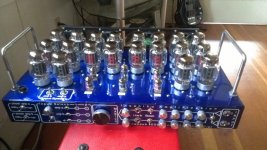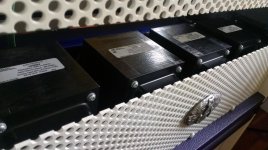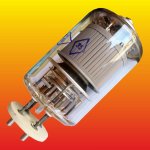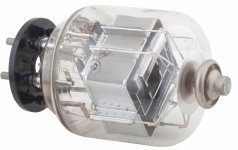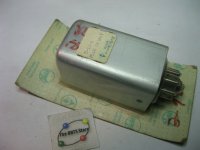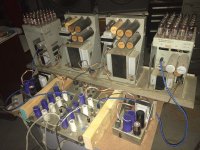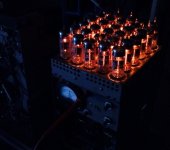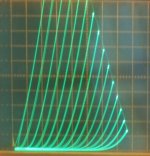Any great sounding & realiable triode-connected balanced PP design for upscaling ?
Dear all,
can you give me some basic schematics or just tips, link maybe, to a great sounding & realiable triode-mode balanced PP design, which could be a strong basis for a 3-400W@8R KT150-based version of the same ?
I'd like to build 2 monoblocks with KT150s parallelled, fully balanced, XLR in, endless power out.
What I need is not ready-to-eat schematics, but rather circuit design tips.
I'd like triode mode for a more pleasant sound however I can't go by the maximum anode dissipation of a KT150 - ideal for strong, high-power amp builds so I would choose them. (+ good availability, I'm not ready for exotics yet).
So I just need some good best-practice cornerstones for the basics. Imagine if you would have to make this monoblock with 2 tubes only - the rest is upscaling, parallelling tubes. (Okay, maybe not THAT easy but let's keep it simple for now).
PS: probably low-noise SMPS, toroidal OPTs but I'm convincable, I just want to walk the unusual way a bit.
Dear all,
can you give me some basic schematics or just tips, link maybe, to a great sounding & realiable triode-mode balanced PP design, which could be a strong basis for a 3-400W@8R KT150-based version of the same ?
I'd like to build 2 monoblocks with KT150s parallelled, fully balanced, XLR in, endless power out.
What I need is not ready-to-eat schematics, but rather circuit design tips.
I'd like triode mode for a more pleasant sound however I can't go by the maximum anode dissipation of a KT150 - ideal for strong, high-power amp builds so I would choose them. (+ good availability, I'm not ready for exotics yet).
So I just need some good best-practice cornerstones for the basics. Imagine if you would have to make this monoblock with 2 tubes only - the rest is upscaling, parallelling tubes. (Okay, maybe not THAT easy but let's keep it simple for now).
PS: probably low-noise SMPS, toroidal OPTs but I'm convincable, I just want to walk the unusual way a bit.
Don't waste your time with KT150 for triode. 6P45S or other large sweep tubes work a lot better in triode in my experience, and last a lot longer. a 6P45S can dish out over 800mA on peaks. Kt150 can not.
With 2 6P45S tubes, you get ~80W, with 4 tubes (and the same load - 1k3) you'll get ~115W. but if you drop the OPT down to 600R, you'll get over 200W.
If you double the tubes but use 6P36S you'll get about the same power, but the tubes are about 5 dollars each.
See my monobloc thread for more info. Here's a post to the schematic. https://www.diyaudio.com/forums/tubes-valves/331934-6p45s-ppp-monoblocks-7.html#post5883883 It's not balanced but that wouldn't be very difficult to implement.
With 2 6P45S tubes, you get ~80W, with 4 tubes (and the same load - 1k3) you'll get ~115W. but if you drop the OPT down to 600R, you'll get over 200W.
If you double the tubes but use 6P36S you'll get about the same power, but the tubes are about 5 dollars each.
See my monobloc thread for more info. Here's a post to the schematic. https://www.diyaudio.com/forums/tubes-valves/331934-6p45s-ppp-monoblocks-7.html#post5883883 It's not balanced but that wouldn't be very difficult to implement.
^ koda is spot on with what I would recommend you do. Lose the KT150 and go for sweep tubes. The circuit he linked to would be a great starting point, set it up with a differential front end (rather than volt amp then concertina) using a 6n2p, 6n9s, or similar high mu tube and you'll have your balanced inputs very easily.
6p45s should be easy enough to get in the EU, lots of them all over and cheap for NOS. You can pick up a quad cheaper than a single KT150 will cost you, and you will end up with a much more capable tube.
6p36s parallel would be similar output, cheaper but a bit more complex.
6p45s should be easy enough to get in the EU, lots of them all over and cheap for NOS. You can pick up a quad cheaper than a single KT150 will cost you, and you will end up with a much more capable tube.
6p36s parallel would be similar output, cheaper but a bit more complex.
I still don't understand why they try to make that crap KT90-150 in Saratov Russia.
It looks like they tried to be smarter than GEC who invented the KT88/TT21.
GEC knew full well, trying to make the Anode 20-30% taller wouldn't work out, and they were one of the best industrial valve makers in the world with sales in the millions.
When I see that KT150 thing, I laugh and think.... oh well they never had colour TVs any good in the USSR, with nothing worth watching on TV anyhow.
The yankies made some of the most amazing TV scan valves out there.
The Europeans were simply outclassed with that stuff.
I have a load of TV scan valves I bought in.
Run them in parallel and they will conduct an AMP at 700V.
I want to see any modern Russian valve ever get close to that,- AND last 20yrs at full output too!
It looks like they tried to be smarter than GEC who invented the KT88/TT21.
GEC knew full well, trying to make the Anode 20-30% taller wouldn't work out, and they were one of the best industrial valve makers in the world with sales in the millions.
When I see that KT150 thing, I laugh and think.... oh well they never had colour TVs any good in the USSR, with nothing worth watching on TV anyhow.
The yankies made some of the most amazing TV scan valves out there.
The Europeans were simply outclassed with that stuff.
I have a load of TV scan valves I bought in.
Run them in parallel and they will conduct an AMP at 700V.
I want to see any modern Russian valve ever get close to that,- AND last 20yrs at full output too!
Hmm interesting things you say. If there are more of you telling me to forget the KT150 thing, I'm willing to do.
I have a pair of JJ KT88 tubes - sell them ? Or buy +2 or +4 ? Intended for 2 Class A SE monoblocks originally but the OPTs have been damaged during my move into a new home so I can now abadon that project - which I don't really want now anyway, I will need plenty of power soon).
I also have 4 Ulyanov 6C33C-B (6S33S-V) bought originally for building Tim Mellow's OTL but I read a lot here and there about these being unreliable tubes, capable for OTL but a bit on the edge, etc. and it's also just a couple of watts. Would it make sense to try a classic triode pushpull AB with them, or sell them too ?
Back to the 6P45S:
according to this link, these are noval socket type tubes, having an anode dissipation about the same like the KT-88 but the octal socket seems to be more sturdy for me. How about a JJ equivalent, the EL509S ? Seems like a normal EL509 but KT-xx type octal socket. Or doesn't it really matter ? (Dont's misunderstand me, I have no JJ fetish but this particular tube just popped in my mind seeing EL509).
I have a pair of JJ KT88 tubes - sell them ? Or buy +2 or +4 ? Intended for 2 Class A SE monoblocks originally but the OPTs have been damaged during my move into a new home so I can now abadon that project - which I don't really want now anyway, I will need plenty of power soon).
I also have 4 Ulyanov 6C33C-B (6S33S-V) bought originally for building Tim Mellow's OTL but I read a lot here and there about these being unreliable tubes, capable for OTL but a bit on the edge, etc. and it's also just a couple of watts. Would it make sense to try a classic triode pushpull AB with them, or sell them too ?
Back to the 6P45S:
according to this link, these are noval socket type tubes, having an anode dissipation about the same like the KT-88 but the octal socket seems to be more sturdy for me. How about a JJ equivalent, the EL509S ? Seems like a normal EL509 but KT-xx type octal socket. Or doesn't it really matter ? (Dont's misunderstand me, I have no JJ fetish but this particular tube just popped in my mind seeing EL509).
Last edited:
It's a larger 9 pin, not the same as the small noval socket.
I have heard that the JJ 509 has issues arcing at the base, but depending on supply voltage that may not be an issue for you. My only experience with similar types have been with older PL509 tubes, and I really liked them in AB2.
I have heard that the JJ 509 has issues arcing at the base, but depending on supply voltage that may not be an issue for you. My only experience with similar types have been with older PL509 tubes, and I really liked them in AB2.
Don't waste your time with KT150 for triode. 6P45S or other large sweep tubes work a lot better in triode in my experience, and last a lot longer. a 6P45S can dish out over 800mA on peaks..
I have not build it yet, but will do a “Final amp” shortly. Search “Final Amp” for the schematics. Similar to Koda’s recommendations. Koda has a similar schematic posted, but his has another amp stage. If you want big power this is the way to go.
^even with the el34, i had arc overs at the socket with a B+ of 440 vdc, pin 3 to pin 2....
i agree with kodabmax, sweep tubes are the way to go....
smoking-amp did a study of sweep tube cathode capacity, and the 6LF6 came out on top...
amplifier designs start with speaker loads...
400 watts into 8 ohm speakers will require 56 vac output,
output turns ratio then becomes:
say your b+ is 400 volts, so your peak will be around 350 vac or 245 vac rms,
245/56 = 4.375; primary anode to anode load then becomes 153 ohms
your half opt impedance is 38 ohms, and b+ of 400 volts this becomes insane at 10 amps of peak current, man we are talking solid state levels here....
say you get a kt150 and bias that for 400 volts and 40 watts plate, so that each tube is biased 100ma, so then you will need 70 tubes per side......
so you can imagine not many amps are designed like this, and in triode even,
pentode mode and things become more plausible...
others more knowledgeable can correct me...you are in for a tough time...
on a plus note, making output traffos of such impedances are far easier to make than ones with higher impedances plate to plate..
i agree with kodabmax, sweep tubes are the way to go....
smoking-amp did a study of sweep tube cathode capacity, and the 6LF6 came out on top...
amplifier designs start with speaker loads...
400 watts into 8 ohm speakers will require 56 vac output,
output turns ratio then becomes:
say your b+ is 400 volts, so your peak will be around 350 vac or 245 vac rms,
245/56 = 4.375; primary anode to anode load then becomes 153 ohms
your half opt impedance is 38 ohms, and b+ of 400 volts this becomes insane at 10 amps of peak current, man we are talking solid state levels here....
say you get a kt150 and bias that for 400 volts and 40 watts plate, so that each tube is biased 100ma, so then you will need 70 tubes per side......
so you can imagine not many amps are designed like this, and in triode even,
pentode mode and things become more plausible...
others more knowledgeable can correct me...you are in for a tough time...
on a plus note, making output traffos of such impedances are far easier to make than ones with higher impedances plate to plate..
With sweep valves, G2 (screen) voltages will be your most serious limitation. If I were trying to do this with oxide cathode valves I'd first look at partial rather than full feedback to the G2s. This alone doubles (+3dB) maximum output.
You'll need custom output transformers and a heroic driver stage anyway, so placing part of the load between cathodes and signal ground, like a Quad or a McIntosh, is painless. G2s are then fed with a well regulated, and lower, voltage supply, something appropriate to the valves' design intent. Just an option.
All good fortune,
Chris
You'll need custom output transformers and a heroic driver stage anyway, so placing part of the load between cathodes and signal ground, like a Quad or a McIntosh, is painless. G2s are then fed with a well regulated, and lower, voltage supply, something appropriate to the valves' design intent. Just an option.
All good fortune,
Chris
A multiple module design would be more flexible, reliable, and transportable. And can be built with off the shelf iron.
Use 6 KT88 or 4 or 6 big Sweep tubes with each Hammond 1650W OT, with "shunt Schade" local N Fdbks to get triode like performance. 280 Watts output per module. Can either be used individually or 16 ohm outputs of two modules are paralleled to get an 8 ohm output at twice the power.
pictures are of a non modular mechanical design, but apparently electrically modular. (at least -could- be electrically modular, might all just be wired up in parallel too)
Use 6 KT88 or 4 or 6 big Sweep tubes with each Hammond 1650W OT, with "shunt Schade" local N Fdbks to get triode like performance. 280 Watts output per module. Can either be used individually or 16 ohm outputs of two modules are paralleled to get an 8 ohm output at twice the power.
pictures are of a non modular mechanical design, but apparently electrically modular. (at least -could- be electrically modular, might all just be wired up in parallel too)
Attachments
Last edited:
Uh, great. I think it will be good if I manage 300W into 8 Ohms.
(Actual load will be at around almost exactly 6 Ohms according to impedance curve and it won't change much, the blocks are intended to be part of a big active 3-way, driving midrange only, where the speaker drivers' impedance point is far below the lower crossover point so the monoblocks would drives the midrange section in a relatively easy-to-manage, predictable and calm impedance range, without the peak. Fs is at ~60Hz and they begin to work from 125Hz, 4th grade Linkwitz-Riley electronic and later digital XO).
But I see the limitations, still very useful tips. Just what I wanted to know Many-many thanks !!!
Many-many thanks !!!
(Actual load will be at around almost exactly 6 Ohms according to impedance curve and it won't change much, the blocks are intended to be part of a big active 3-way, driving midrange only, where the speaker drivers' impedance point is far below the lower crossover point so the monoblocks would drives the midrange section in a relatively easy-to-manage, predictable and calm impedance range, without the peak. Fs is at ~60Hz and they begin to work from 125Hz, 4th grade Linkwitz-Riley electronic and later digital XO).
But I see the limitations, still very useful tips. Just what I wanted to know
Can you tell me any US sweep tube that outperforms the ratings of an European PL519?The yankies made some of the most amazing TV scan valves out there.
The Europeans were simply outclassed with that stuff.
Best regards!
All the big TV Sweeps I've seen look virtually identical to the PL519/6KG6 except some of the GE 6LW6 have bigger bottles, but the same size guts inside.
----------------
If the amplifier does not have to work the low frequencies, then the OT can be considerably smaller. But would require a custom wind to get the bigger wire for the high power level. Probably cheaper to just get an off the shelf designed OT. That Hammond 1650W looks about the size of a 500 Watt 60 Hz xfmr.
For 6 Ohm output, maybe could get Hammond to do a custom mod., worth a try. The standard 8 Ohm version would just look like a 1450 Ohm primary with a 6 Ohm load on the 8 Ohm secondary. But the "official" current rating of the secondary would not be up to spec. for 280 Watts then.
------------------
For these Jumbo size amplifiers, one should take a look at using Hf impedance conversion (David Berning stuff) and switching power supplies. A tube amplifier could potentially be lighter weight than a SS linear type amplifier, without all the heavy metal (xfmrs). And NO big heatsinks like SS, just some fans. Technical complexity for sure though.
Then there is class D pulse type stuff. Can use some big Radar pulse tubes then. (pics) PWM chips, hide them under the chassis or: (3rd pic: octal chip camouflage)
----------------
If the amplifier does not have to work the low frequencies, then the OT can be considerably smaller. But would require a custom wind to get the bigger wire for the high power level. Probably cheaper to just get an off the shelf designed OT. That Hammond 1650W looks about the size of a 500 Watt 60 Hz xfmr.
For 6 Ohm output, maybe could get Hammond to do a custom mod., worth a try. The standard 8 Ohm version would just look like a 1450 Ohm primary with a 6 Ohm load on the 8 Ohm secondary. But the "official" current rating of the secondary would not be up to spec. for 280 Watts then.
------------------
For these Jumbo size amplifiers, one should take a look at using Hf impedance conversion (David Berning stuff) and switching power supplies. A tube amplifier could potentially be lighter weight than a SS linear type amplifier, without all the heavy metal (xfmrs). And NO big heatsinks like SS, just some fans. Technical complexity for sure though.
Then there is class D pulse type stuff. Can use some big Radar pulse tubes then. (pics) PWM chips, hide them under the chassis or: (3rd pic: octal chip camouflage)
Attachments
Last edited:
I'll remain at Class AB. If the project with tubes is going to be too big, I might build a 'weaker' tube amp from the existing tubes and bulid a Mosfet for this particular application. Bass is Class D already, tweeter gets Mosfet, only the midrange is like 'hmm why not try it with tubes, even if it's a monster then?'. After all this I'm not sure I shall walk the tube way for this application. Nevertheless, a good basic Class AB design is always welcome.
Thanks for the comments to all of you.
Thanks for the comments to all of you.

Take a look at the STC thread. SS amps made to emulate triodes.
Super Triode Connected (STC) chip amp
Maybe also of some interest:
https://www.diyaudio.com/forums/tub...put-transformer-suggestion-2.html#post5989735
--------------------------------
Certainly. Many big 813 Amps around. I try to steer clear of the lethal B+ type transmitting tube designs though. If one could just find a box of YL1260 tubes, bingo.
Now for something truly different.
JAN 6197 tubes were on sale recently (last Spring) for $0.33 each. For $13 one could parallel up 40x 6197 tubes to get 300 Watts. They even have nice triode mode curves (pic3 below). Well, the sockets and labor are not accounted for.
There really was an OTL amp using 30x 12B4 tubes per channel, there was a thread on it last year:
Killer OTLs
Super Triode Connected (STC) chip amp
Maybe also of some interest:
https://www.diyaudio.com/forums/tub...put-transformer-suggestion-2.html#post5989735
--------------------------------
you can easily get these sort of powers with just pairs of 813s.
Certainly. Many big 813 Amps around. I try to steer clear of the lethal B+ type transmitting tube designs though. If one could just find a box of YL1260 tubes, bingo.
Now for something truly different.
JAN 6197 tubes were on sale recently (last Spring) for $0.33 each. For $13 one could parallel up 40x 6197 tubes to get 300 Watts. They even have nice triode mode curves (pic3 below). Well, the sockets and labor are not accounted for.
There really was an OTL amp using 30x 12B4 tubes per channel, there was a thread on it last year:
Killer OTLs
Attachments
Last edited:
- Status
- This old topic is closed. If you want to reopen this topic, contact a moderator using the "Report Post" button.
- Home
- Amplifiers
- Tubes / Valves
- Any great sounding & realiable triode-connected balanced PP design for upscaling ?

